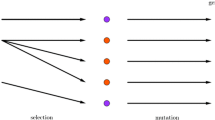Abstract
A generalization of the “constant overall organization” constraint of Eigen's quasispecies and hypercycle models, called herein “global population regulation”, is shown to lead to mathematically tractable spatial generalizations of these two models. The spatially uniform steady state of Eigen's quasispecies model is shown to be stable and globally attracting for all possible values of the mutation and replication rates. In contrast, the spatially and temporally uniform solutions to the hypercycle with fewer than five members, the only ones insensitive to stochastic perturbations, are shown to be unstable, and a lower bound to the spatial inhomogeneities is obtained. The prospect that the spatially localized hypercycle might be immune to various instabilities cited in the literature is then briefly considered. Although spatial localization makes possible a much richer dynamical repertoire than previously considered, it is also more difficult to understand how Darwinian selection of hypercycles could result in a unique genetic code.
Similar content being viewed by others
Literature
Bauer, G., J. McCaskill and H. Otten. 1989. Travelling waves ofin vitro evolving RNA.Proc. natn. Acad. Sci. U.S.A. 86, 7937–7941.
Bresch, C., U. Niesert and D. Harnasch. 1980. Hypercycles, parasites, and packages.J. theor. Biol. 85, 399–405.
Cairnes-Smith, A. G. 1985. The first organisms.Scient. Am., June edition.
Cantor, C. R. and P. R. Schimmel. 1980.Biophysical Chemistry, Part I:The Conformation of Biological Macromolecules, and Part II:Techniques for the Study of Biological Structure and Function. San Francisco: W. H. Freeman.
Eigen, M. 1971. Self-organization of matter and the evolution of biological macromolecules.Naturwissenschaften 58, 465–532.
Eigen, M. and P. Schuster. 1979.The Hypercycle. New York: Springer.
Eigen, M., J. McCaskill and P. Schuster. 1989. The molecular quasi-species.Adv. chem. Phys. 75, 149–263.
Fox, S. W. and K. Dose. 1977.Molecular Evolution and the Origin of Life. New York: Marcel Dekker.
Jones, B. L., R. H. Enns and S. S. Rangnekar. 1976. On the theory of selection of coupled macromolecular systems.Bull. math. Biol. 38, 15–28.
Mills, D., R. Peterson and S. Spiegelman. 1967.Proc. natn. Acad. Sci. U.S.A. 58, 217.
Niesert, U., D. Harnasch and C. Bresch. 1981. Origin of life between scylla and charybdis.J. molec. Evol. 17, 348–353.
Percus, J. K. 1984.Mathematical Methods in Enzymology, Courant Institute Lecture Notes. New York: The Courant Institute of Mathematical Sciences.
Rodriguez-Vargas, A. and P. Schuster. 1983. The dynamics of catalytic hypercycles—a stochastic simulation. In:Stochastic Phenomena and Chaotic Behavior in Complex Systems, H. Haken (Ed.). Berlin: Springer.
Schuster, P. 1988. Potential functions and molecular evolution. In:From Chemical to Biochemical Organization, Springer Series in Synergetics, Vol. 39, M. Marcus, S. Mueller and G. Nicolis (Eds). Berlin: Springer.
Schuster, P. and K. Sigmund. 1980. A mathematical model of the hypercycle. In:Dynamics of Synergetic Systems, H. Haken (Ed.). Berlin: Springer.
Stoer, J. and R. Bulirsch. 1980.Introduction to Numerical Analysis. New York: Springer.
Author information
Authors and Affiliations
Rights and permissions
About this article
Cite this article
Weinberger, E.D. Spatial stability analysis of Eigen's quasispecies model and the less than five membered hypercycle under global population regulation. Bltn Mathcal Biology 53, 623–638 (1991). https://doi.org/10.1007/BF02458632
Issue Date:
DOI: https://doi.org/10.1007/BF02458632




